Centaur
The centaur is an intelligent, monstrous hybrid species with the combined features of a mortal and a horse. Believed to have been created by the nature goddess Acien Tali following her transformation into the Mother of All Wilds, centaur are a diverse species belonging to a variety of ethnicities. In general, centaurs tend to live in nomadic or semi-nomadic societies, as most sedentary civilizations are not structured to accommodate their unique anatomies. Though they could once be found on every continent in Holos, a combination disease, warfare, and colonization during the Palladian Era destroyed nearly the entire population of Auloan and Nioan centaurs. Today, they can be found in communities across Iroa, Hakoa, and Teroa; as well as in the Feywild and the woodland realms.
Basic Information
Anatomy
While centaurs appear to be the basic combination of hominids and equids, they in fact have a number of specialized anatomical features designed to make the most out of their unique morphology.
Skeleton
Their entire body is supported by large vertebrae more similar in size and structure to giraffes than to most equids. As the spine curves upward from the posterior thorax to the anterior's trunk, the spinal column is insulated with air pockets to allow it to withstand the force exerted by the anterior while in full gallop. These air pockets also allow the centaur to lock their anterior in place while moving, similar to how birds are able to hold their head in place while their body sways underneath them. This grants the centaur's an incredible range of movement, allowing it to twist the trunk and head to look behind it. It also enables the upper body enhanced stability, which can be seen in the improved accuracy among centaur archers. The centaur's anterior trunk has an extended hominid rib cage, containing a prodigious set of lungs and an enlarged heart. Centaurs have developed a larger sternum structure than most equine animals, as well as a set of ilioclavicular bones, to help the increased bulk of the anterior. The sternum also connects to the centaur's operculum. Centaur skulls appear quite similar to most mortals. They have wider nasal openings and a developed nasal bone to facilitate increased oxygenation. Their maxila and zygomatic arches are enlarged, alluding to a largely herbivorous diet and their craniums are about the same size as most other mortals.Operculum
The operculum is an organ unique to centaurids. They are a set of openings located above the caudal bones and to either side of the anterior trunk's thorax. These openings are connected to a secondary set of lungs located in the equine posterior and function similar to nostrils. However, unlike nostrils, they are not connected to the centaur's trachea. This dual lung set setup allows the centaur to continually pump large amounts of oxygen to their posterior, even when running at full speed. The posterior's circulatory system is further aided by a smaller, secondary heart directly connected to a well-developed vascular system in the animal's legs and hooves.Musculature
Centaurs have exceptionally well-developed musculature and circulation overall. This is supported by their dual heart and dual lung set up, which allows their muscles to receive more oxygen at a faster rate than mortals or equids. They have proportionally longer arms than most bipedal mortals and more robust deltoids to compensate for their large posture. In addition to their skeletal structures, the centaur's thorax has a large symmetrical muscular shield made up of interlocking fibers derived from their pectoral regions. This further facilitates their flexible range of anterior movements as well as providing support for the anterior's complex structures.Genetics and Reproduction
Much of centaur reproduction mimics equine reproduction. Female centaurs have an estrous cycle, but unlike horses, centaur estrous cycles are not tied to the season but to the moon, specifically the moon of Tali. Some claim this is similar to the female human estrous cycle but it likely derives from their divine parentage at the hands of Acien Tali. Under these conditions, often called a "mating moon," the female centaur is receptive to a male centaur and able to conceive. Centaurs are unable to conceive offspring with any other known species, including other equines.
Centaur gestation lasts for a period of about 380 days and usually results in a single foal, with twins being exceptionally rare. Because of the position of centaur's breasts, female centaurs must lie supine in order to breast feed their young. Foals are typically weaned from their mothers after just six months.
Growth Rate & Stages
Foals are born able to walk and run. After being weaned, the centaurs grow rapidly, entering puberty around age five and becoming sexually mature at age nine. However, in all but the most primitive centaur communities, most foals are not considered adults until around age 16 or 17. Between sexual maturity and full adulthood, young centaurs undertake a spiritual journey called the protoporos. During this period, young centaurs are expected to undergo a kind of self-discovery as well as expel the excessive youthful energy that most young centaurs experience. Unfortunately, many mortal communities that have encountered centaurs in the midst of their protoporos see the lineage as a wild, drunken, and sex-crazed people. After the protoporos is completed, most centaur return to their herds, where they can live for up to 80 years. Some claim that centaurs living in places thick with the Old Magic, such as the Feywild, have been reported to live upwards of 200 years but this has yet to be substantiated.
Ecology and Habitats
Historically, centaurs lived in the wilderness; rarely joining settled communities and instead living as nomadic herdsfolk and hunter-gatherers. They primarily congregated in temperate and subtropical zones, particularly in forests, scrublands, and open savannah or steppe habitats. Though not built for extreme alpine environments, some did move into higher elevations, such as the windswept plateaus of Rhalpalkan . They also avoided dense forests or rain forests where travel was limited by thick foliage or frequent precipitation.
However, over the centuries as more and more mortal settlements have appeared, centaur populations have become more and more fragmented. Some have remained in their traditional woodland homes and keep to a nomadic way of life even today. Others have, either by choice or circumstance, integrated into sedentary mortal communities. These centaur still tend to remain in the countryside and avoid settlement in highly urban environments. This is because the urban landscape, like that of the jungle or dense forests, are not physically accommodating to centaur physiology. Hooves are easily chipped on cobblestones, door frames are built for smaller folk, and the sheer size of the centaur makes them likely to fall through many structure's floors. As a result, most centaurs remain a stubbornly rustic people.
Dietary Needs and Habits
Centaurs are omnivorous, like most sentient folk. Unlike many mortals, centaurs lack canines and are not well suited for ripping flesh with their teeth. Centaurs are able to digest grasses and other fibrous plant material better than many other intelligent creatures. This is supplemented with a diet of nuts, fruits, vegetables and meats. Most centaur cultures are hunter-gatherers or nomads and regularly eat goats, sheep, rabbit, fowl, deer, and antelope.
Some centaur communities, such as the Samartha of northern Iroa practice cannibalism. While many in the region claim that these centaur also eat other mortals, the Samartha's tradition is focused on consuming members of their own community, either during a sacrificial ritual or in a funerary rite for a naturally deceased centaur. In either case, endocannibalism is rare in these societies and they do not actively see members of their community as sources of food.
Additional Information
Perception and Sensory Capabilities
Centaurs have reasonable perception abilities but lack many of the heightened senses of horses and other prey animals. Their eyesight is about that of a human, though their anterior spinal column's stability while on the move often allows them more accurate vision, particularly over long distances. They have slightly improved senses of smell, owing to their enlarged nasal cavities. Their hearing is also about that of a human and nowhere near as sharp as that of an equine.
Civilization and Culture
Average Technological Level
Because most centaurs still live as hunter-gatherers and nomads, much of their communities' technology remains Neolithic. Stone, wood, and bone implements are common and most clothing is made of furs or skins. However, in centaur communities that trade with mortals and other outsiders, metal and other refined materials are often exchanged for hunted or foraged items, with many mortals trading fortunes for rare furs or logging rites. Centaurs that live closer to mortal societies or that are fully integrated into mortal communities use technology as readily as any other people.
Centaurs do have a natural proclivity for natural and fey magics and often have insight into places of power located in the wilderness. Those that do often also boast powerful magical users in their herds. Typically, these magic users are shamans or druids with some basic knowledge of alchemical brewing and arcane enchantment. Few of these centaur shamans produce magical goods for sale, but the methods for obtaining potions or enchantments is known and utilized by their communities.
History
Dawn to Mithril Era
The first centaurs were widely believed to have been created during the Dawn Era by the goddess Acien Tali, following her transformation from the goddess Talessra. It is said that she created them to be the stewards of the wilderness and to be a physical bridge between mortals and beasts. To them, she imparted her knowledge of the Green Magic and, in so doing, made them the first druids. They went on to spread across Holos's wild regions and though they never settled in any one place, their presence could always be felt when the land breathed. A few tribes even found their way into the Feywild, stumbling into the Rainbow Realm through fairy circles and other thin places lost to the wilds. There, they were welcomed by both the Seelie and Unseelie Courts and have remained a fixture of the Feywild's diverse fair folk. By the end of the Dawn Era and the beginning of the First Intermediate Period, centaurs had made their way to every continent, particularly those with the greatest stretches of savannah and open woodland. In Khaghat, they established a nomadic culture known as the Samartha, herding sheep and following the saiga across the steppe each season. The Samartha played a prominent role in the development in the multi-lineage Khaghate culture, serving as a constant foe, trading partner, and point of contrast. Some centaur even came to adopt the Khaghate culture as their own and follow the Khaghate's Ogadinui even to this day.Rise of the Palladian Empire
Centaurs appear in tales set throughout the Mithril Era as heroes, villains, and wise guides to the natural world. However, following the Reckoning of Temekan, the gods of the Heavenly Council largely withdrew from the active affairs of the Material Plane and established the Exile Arcana. Soon after this period, a mortal state called the Palladian Empire rose to power. Shaken by the events of the Reckoning and in the absence of their deities' guidance, the Palladians came to see themselves as the rightful rulers of the Material Plane. Their ideology, while once respectful of centaurs and other peaceful monstrous races, soon came revile them as vestiges of the arcane. This manifested in the early Palladian Era as forced relocations and brief, violent struggles with the few Kaneshite and Mashiqi centaurs that still inhabited Nioa. These centaur communities were pushed into the Bashari Timberlands, where they were largely ignored, though some of their kind were pressed into service as auxiliaries. In 292 PE, the Palladians began a series of military campaigns in Auloa. This soon led to the Palladians launching a major invasion of the continent and the establishment of a new provincial colony called Placidia. The indigenous folk of Placidia—an amalgam of gnomish, dwarvish, halfling, and centaur tribes—were either subjugated, enslaved or otherwise forcibly incorporated into the Palladian Empire. At first, they fought the invaders as individual communities, but each time they were defeated by the better trained and equipped Palladians.Peliad's Rebellion
However, in 327 PE, a centaur leader named Peliad led an uprising of Placidian centaurs, minotaurs, and other monstrous races against the Palladians. The campaign nearly saw the Palladians driven off the continent, with their forces cut off from one another. However, thanks to the betrayal of several gnomish cohorts and a daring counterattack by the Palladian General Caelia Falx at the Battle of Whitehill, the confederacy's forces were decimated and Peliad himself was captured. Peliad was taken to Iskendra, where he was paraded through the streets before brutally mutilated in the Caelian Arena.1 With the death of Peliad, the centaurs of Placidia were scattered and extremely demoralized. The Palladians continued to tighten their grip on Placidia, leading to the final conflict of the Placidian Wars, the Greenleaf Rebellion. Though several tribes of centaurs of participated in the war, but most chose instead to relocate to Czeršia in the south. The more densely wooded region resisted colonization far longer than the other Brass Sea colonies, but it too fell2 into Palladian control in 451 PE.Disease & Near-Extinction
Owing to the plight of the centaurs, a disease believed to originate in the horses of the Palladian cavalry soon spread to the centaurs in 439 P.E. This disease, called the Mermacid Flux, was mild in horses but deadly in centaurs as it diminished the amount of oxygen in their lungs and caused them slowly suffocated them under their own weight. It spread like wildfire through centaur communities, thanks in part to the Czeršian Wars and the increased number of refugees and other ailments. Though it was not noticed by chroniclers at the time, it is widely believed that the plague killed nearly 3/4ths of all centaurs in Czeršia by 450 PE. The Mermacid Flux would go on to kill thousands more centaurs across Auloa, with estimates ranging from 50,000 to 300,000 centaurs dying of it by end of the 5th Century. This ravaging disease, combined with the continued Subjugation of Auloa, effectively drove the last remaining Auloan centaur tribes into hiding. After a certain point, even the Palladians started to notice the apparent extinction of the species. Some, particularly those in the Palladian military who recalled their terrifying battle charges, saw their disappearance as boon to the continued colonization of Auloa. Others, many writers and cultural critiques, decried the "death of the centaur." These artists came to reexamine Peliad's Rebellion and mythologized stories about the centaurs, casting them as "noble savages" led astray by a misunderstood leader. As a result of this reinterpretation, many contemporary documents from days of the Rebellion have been thoroughly edited and it has become difficult to parse what is sensationalized re-imagining and what is historical fact.The Sundered Era
With the Sundering Arcana, the Palladian Empire crumbled to total ruin in Auloa. In the immediate aftermath, many once colonized peoples reclaimed their territory and place in the world. And though much of the trappings of the Empire soon fell away, it has become clear that even in places like Czeršia and Reikerk, where the Palladian's hold was the weakest, the influence of their imperial culture remains in fragments. Despite this, what few tribes of Auloan centaurs remain have largely stayed in self-isolation. They are primarily found in places like the Mistwood and the Mehilan, where their connection to the Mother of All Wilds remains strong. Many mortals in Auloa remain convinced that centaurs are either extinct or a myth invented by the Palladians to justify their occupation. Time will tell if Auloan centaurs will rejoin mortal society, or if they will continue to prefer the company of the protective trees and ancient spirits.Footnotes
1 Most accounts claim Peliad was hunted in a traditional animal fight, while some others contend he was made to race for his freedom against the Emperor's prize stallion while wearing devices on his legs that cut into his tendons with each step. In both versions, the triumph ended with Peliad's body being cut in half and a horse's head sown on his lower body while his upper body was attached to a grim puppeting mechanism and paraded back through the streets.2 Zegesthusa's Stand; the last conflict of the Czeršian Wars.
Scientific Name
Kentauris anthrippus
Lifespan
~80 years
Conservation Status
Near Extinct in Auloa and Nioa
Average Height
~2 m (6.5-7.5 ft.) and 1.5 m (5 ft.) at the withers
Average Weight
550-700 lbs (~1212-1543 lbs.)
Average Length
~2.4 m (8 ft.)
Geographic Distribution
The bucolic countryside of Kanesh, once thought to be where centaurs were first created
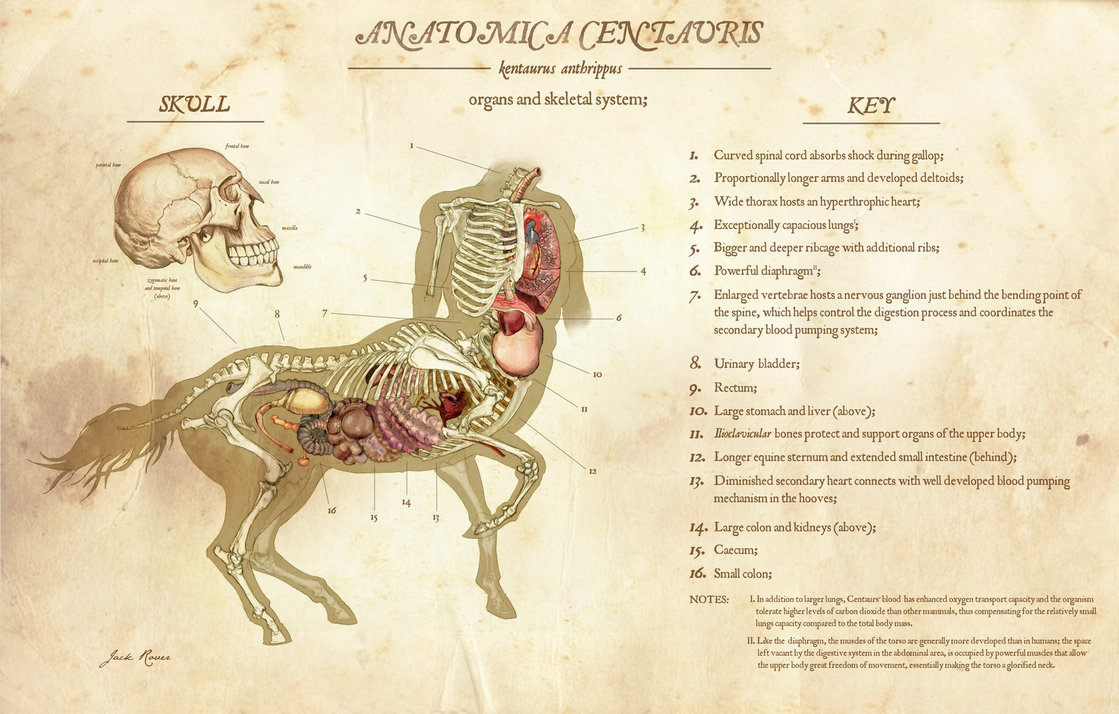
Anatomica Centauris by Jack Rover
Some centaurs in mortal societies have adopted advanced weapons and technology
An example of Late Palladian centaur revisionist art

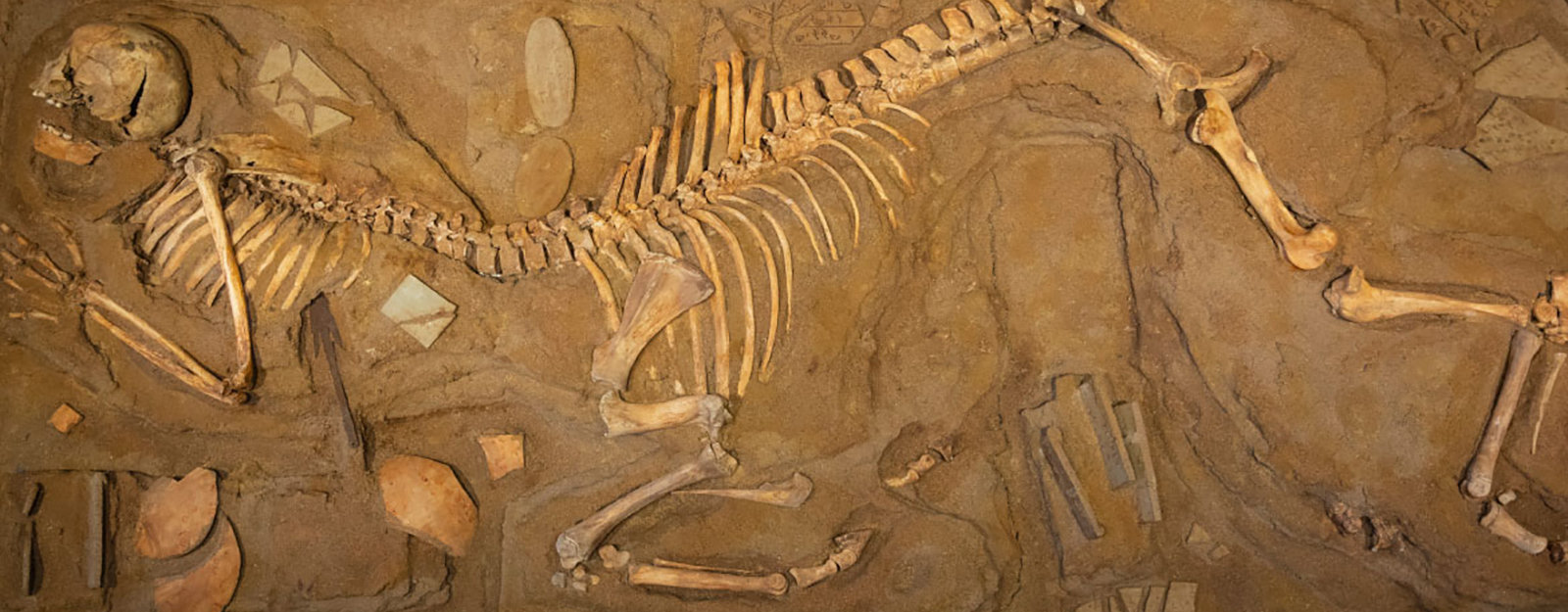
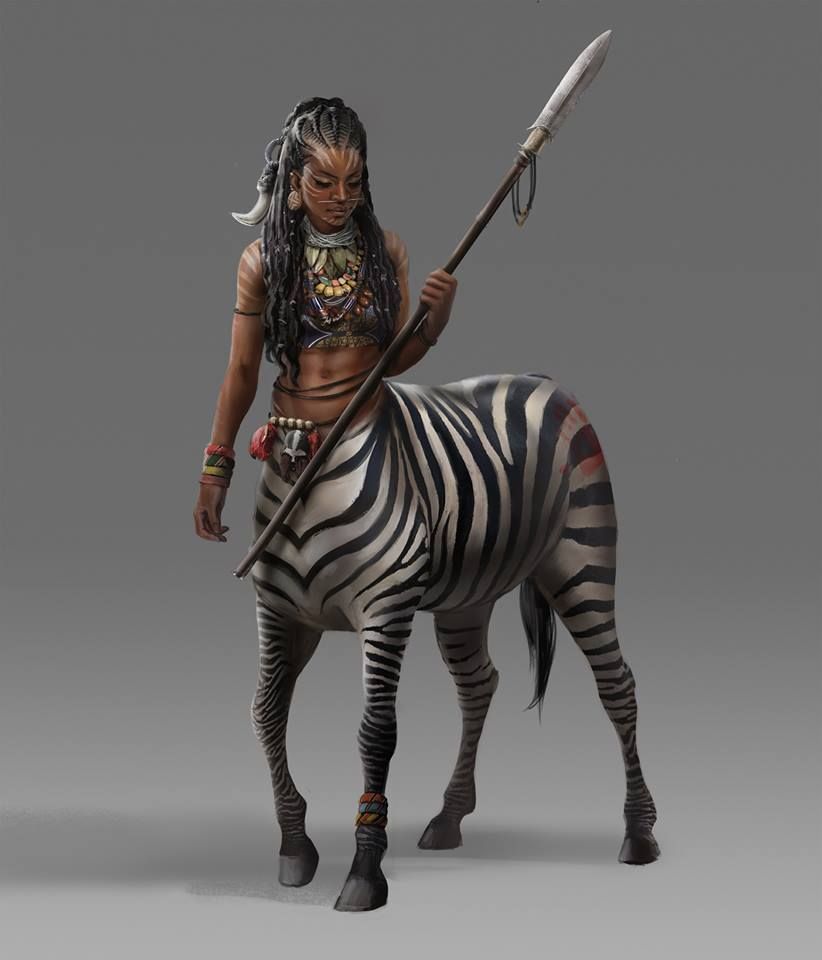
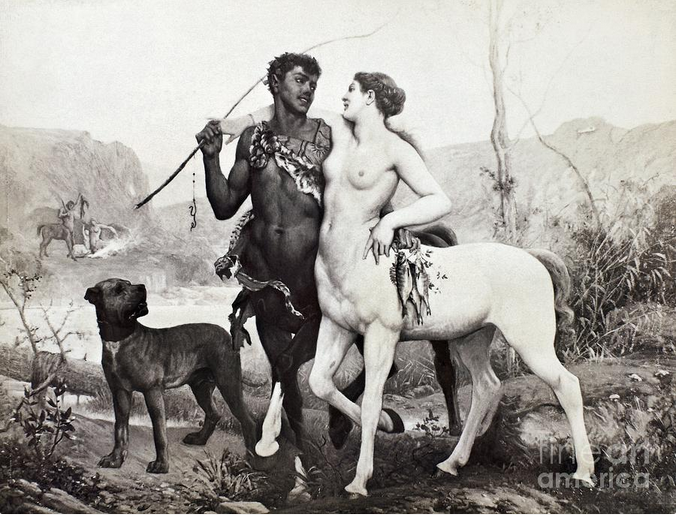
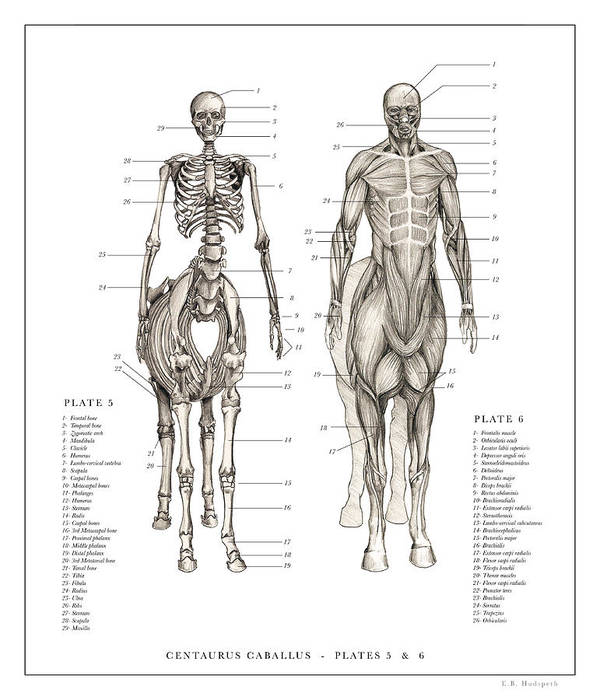
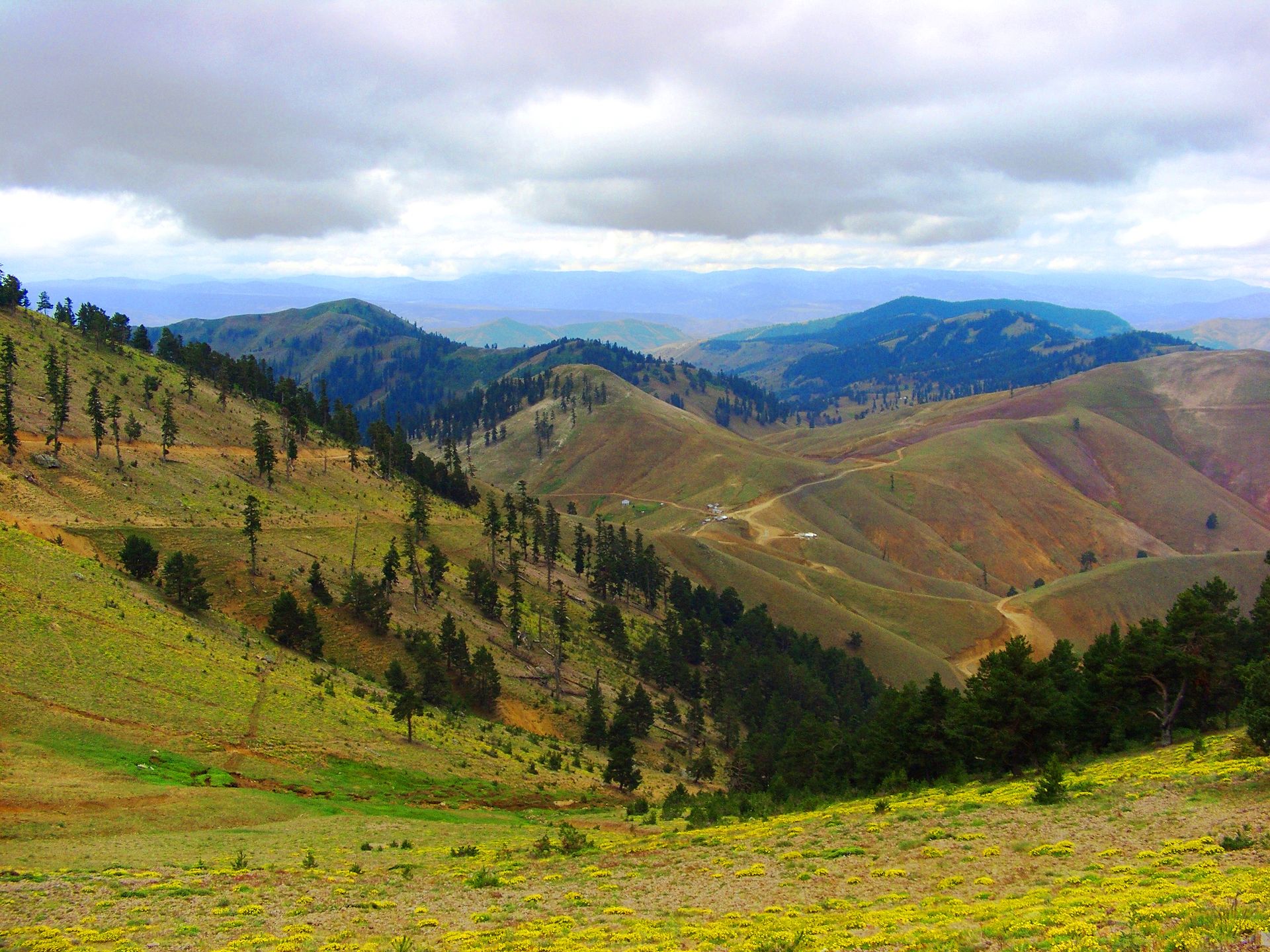
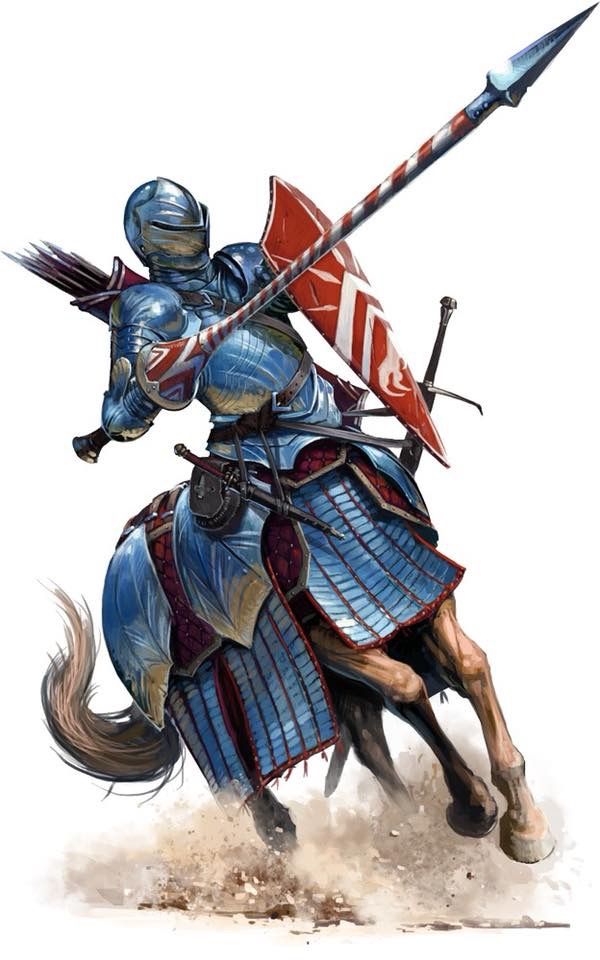
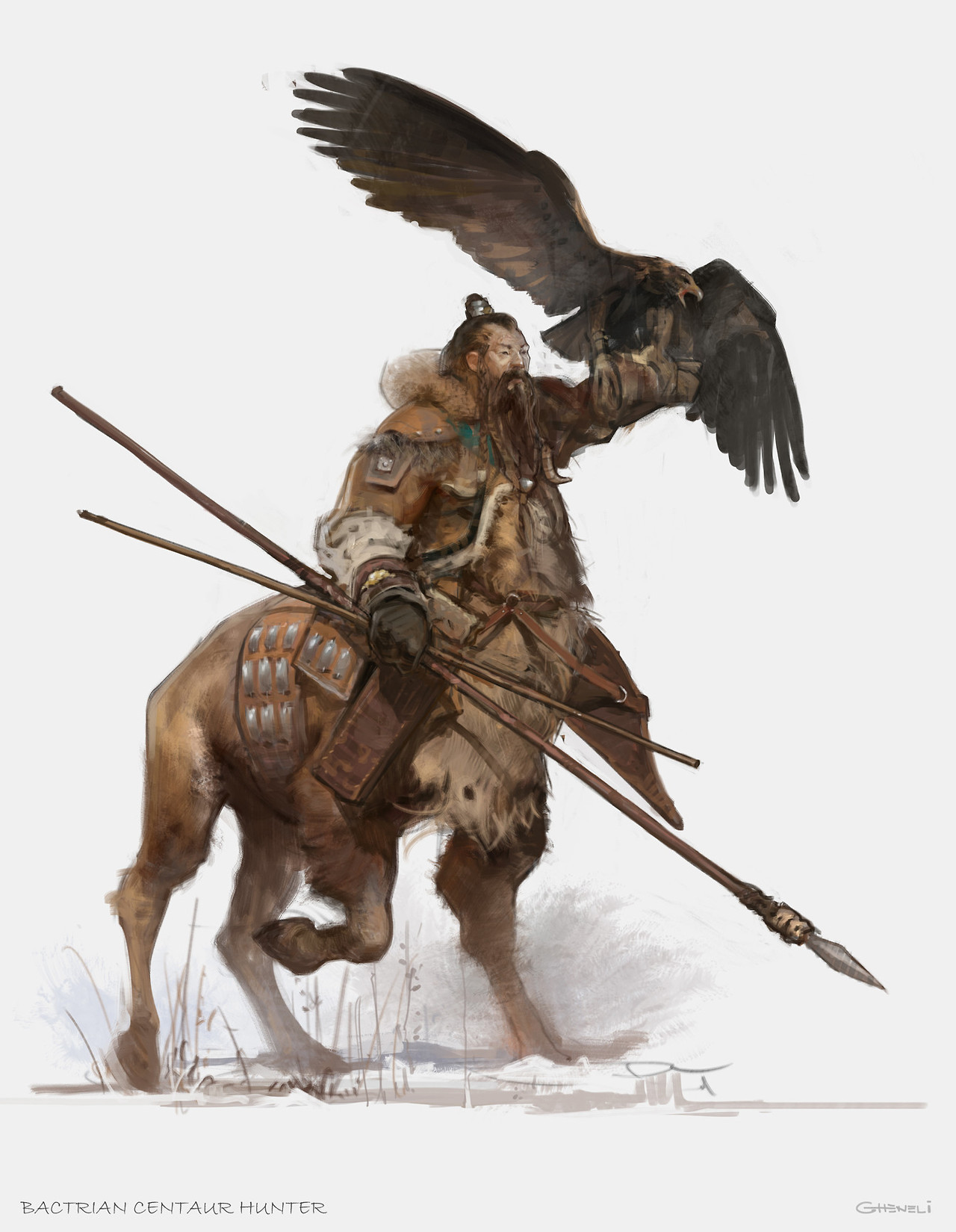
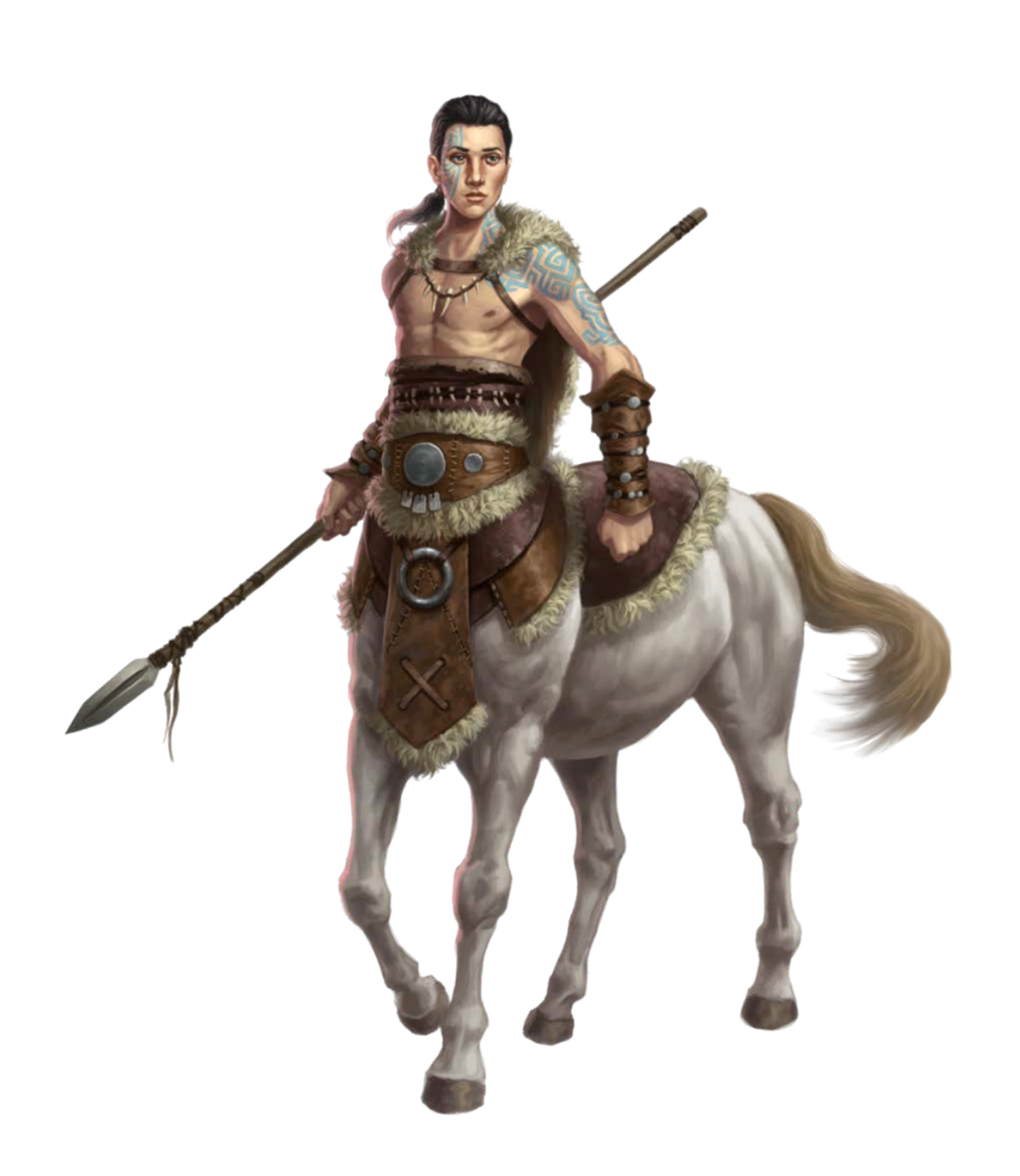
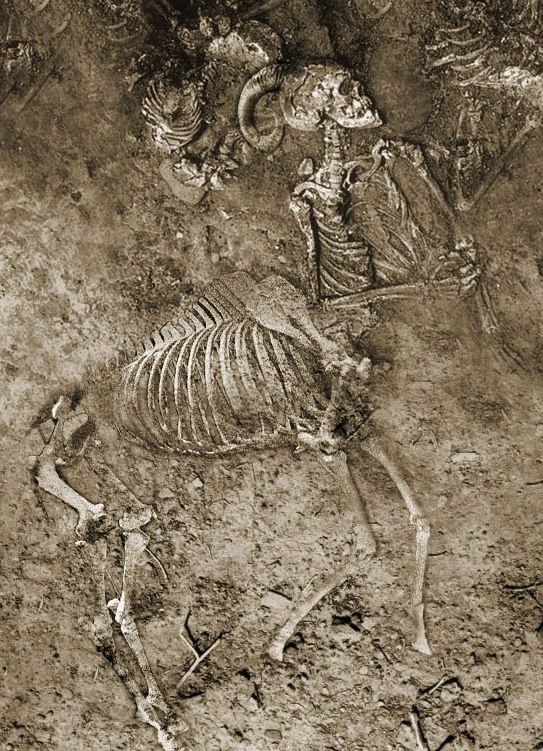
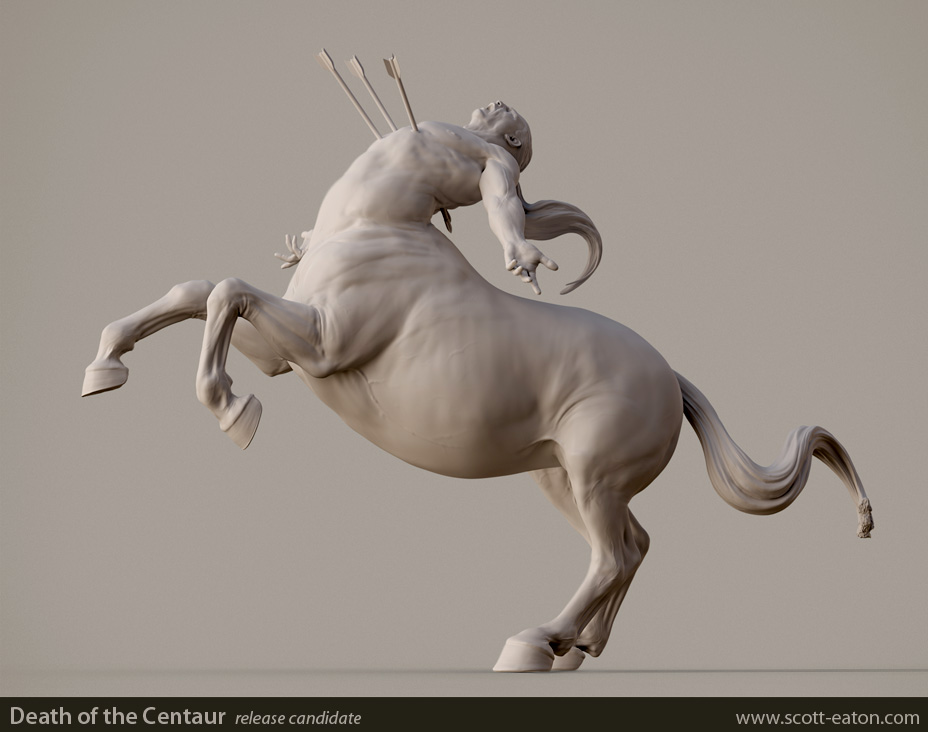
Comments